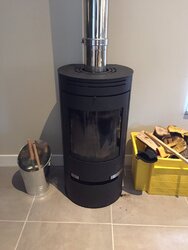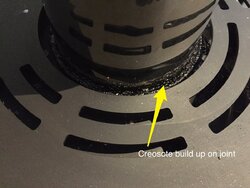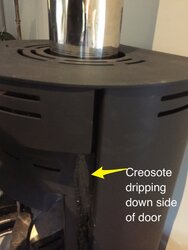We're in the SW of France, where the weather has turned and we've had an Arduro wood stove installed a couple weeks ago. We ran it on and off over a few days with all seeming to go well until yesterday morning, when we woke to a very strong smell in the house. I had a look at the stove and found that around the join between the chimney and stove, there was a tarry liquid bubbling away and the source of the smell. We'd been using oak, that's apparently seasoned, so I was surprised that this was there, not to mention how quickly such a large amount had built up (it's run from the joint, over the top plate (below an insulating plate...so hard to reach!) and down along the doorway to the floor).
I let everything cool down and cleaned out the stove and have 2 questions:
1- I've never installed a stove, so am not really qualified to assess the work, but wonder if the installer simply failed to use a compound to seal the joint (and if compound is always used?). Aside from not using compound, are there other likely reasons for this problem? The person who installed it is a jack-of-all-trades type, employed by the owner of the house we're renting and it would be helpful to understand as much as possible so that we can work together to resolve this. Things can move slowly around here and I don't want it to take many attempts to fix this (I'm also buying a carbon monoxide detector to ensure that we minimise risk to our family, in case it does take several attempts before it's fixed)
2- The tarry substance has hardened, and I'll need to clean it (it's in some hard-to-get-to places as well and gummed up the joint for the damper...argh!). Any recommendations on natural stuff or active ingredients that should be in cleaning products to remove this? Looks like it won't be easy. As I'm out in a rural area, finding products that are common in large (anglo!) building supply places is unlikely here (which is the reason that I'm asking for active ingredients or natural solutions, as that will help track down corresponding products available in France).
Many thanks for any suggestions!
I let everything cool down and cleaned out the stove and have 2 questions:
1- I've never installed a stove, so am not really qualified to assess the work, but wonder if the installer simply failed to use a compound to seal the joint (and if compound is always used?). Aside from not using compound, are there other likely reasons for this problem? The person who installed it is a jack-of-all-trades type, employed by the owner of the house we're renting and it would be helpful to understand as much as possible so that we can work together to resolve this. Things can move slowly around here and I don't want it to take many attempts to fix this (I'm also buying a carbon monoxide detector to ensure that we minimise risk to our family, in case it does take several attempts before it's fixed)
2- The tarry substance has hardened, and I'll need to clean it (it's in some hard-to-get-to places as well and gummed up the joint for the damper...argh!). Any recommendations on natural stuff or active ingredients that should be in cleaning products to remove this? Looks like it won't be easy. As I'm out in a rural area, finding products that are common in large (anglo!) building supply places is unlikely here (which is the reason that I'm asking for active ingredients or natural solutions, as that will help track down corresponding products available in France).
Many thanks for any suggestions!




